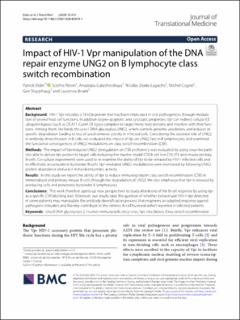| dc.contributor.author | Eldin, Patrick | |
| dc.contributor.author | Péron, Sophie | |
| dc.contributor.author | Galashevskaya, Anastasia | |
| dc.contributor.author | Denis-Lagache, Nicolas | |
| dc.contributor.author | Cogné, Michel | |
| dc.contributor.author | Slupphaug, Geir | |
| dc.contributor.author | Briant, Laurence | |
| dc.date.accessioned | 2022-05-13T13:04:03Z | |
| dc.date.available | 2022-05-13T13:04:03Z | |
| dc.date.created | 2021-01-04T16:47:19Z | |
| dc.date.issued | 2020 | |
| dc.identifier.citation | Journal of Translational Medicine. 2020, 18 (1), . | en_US |
| dc.identifier.issn | 1479-5876 | |
| dc.identifier.uri | https://hdl.handle.net/11250/2995669 | |
| dc.description.abstract | Background
HIV-1 Vpr encodes a 14 kDa protein that has been implicated in viral pathogenesis through modulation of several host cell functions. In addition to pro-apoptotic and cytostatic properties, Vpr can redirect cellular E3 ubiquitin ligases (such as DCAF1-Cul4A E3 ligase complex) to target many host proteins and interfere with their functions. Among them, Vpr binds the uracil DNA glycosylase UNG2, which controls genome uracilation, and induces its specific degradation leading to loss of uracil removal activity in infected cells. Considering the essential role of UNG2 in antibody diversification in B-cells, we evaluated the impact of Vpr on UNG2 fate in B lymphocytes and examined the functional consequences of UNG2 modulations on class switch recombination (CSR).
Methods
The impact of Vpr-induced UNG2 deregulation on CSR proficiency was evaluated by using virus-like particles able to deliver Vpr protein to target cells including the murine model CSR B cell line CH12F3 and mouse primary B-cells. Co-culture experiments were used to re-examine the ability of Vpr to be released by HIV-1 infected cells and to effectively accumulate in bystander B-cells. Vpr-mediated UNG2 modulations were monitored by following UNG2 protein abundance and uracil removal enzymatic activity.
Results
In this study we report the ability of Vpr to reduce immunoglobulin class switch recombination (CSR) in immortalized and primary mouse B-cells through the degradation of UNG2. We also emphasize that Vpr is released by producing cells and penetrates bystander B lymphocytes.
Conclusions
This work therefore opens up new perspectives to study alterations of the B-cell response by using Vpr as a specific CSR blocking tool. Moreover, our results raise the question of whether extracellular HIV-1 Vpr detected in some patients may manipulate the antibody diversification process that engineers an adapted response against pathogenic intruders and thereby contribute to the intrinsic B-cell humoral defect reported in infected patients. | en_US |
| dc.language.iso | eng | en_US |
| dc.publisher | BMC | en_US |
| dc.rights | Navngivelse 4.0 Internasjonal | * |
| dc.rights.uri | http://creativecommons.org/licenses/by/4.0/deed.no | * |
| dc.title | Impact of HIV-1 Vpr manipulation of the DNA repair enzyme UNG2 on B lymphocyte class switch recombination | en_US |
| dc.title.alternative | Impact of HIV-1 Vpr manipulation of the DNA repair enzyme UNG2 on B lymphocyte class switch recombination | en_US |
| dc.type | Peer reviewed | en_US |
| dc.type | Journal article | en_US |
| dc.description.version | publishedVersion | en_US |
| dc.source.pagenumber | 0 | en_US |
| dc.source.volume | 18 | en_US |
| dc.source.journal | Journal of Translational Medicine | en_US |
| dc.source.issue | 1 | en_US |
| dc.identifier.doi | 10.1186/s12967-020-02478-7 | |
| dc.identifier.cristin | 1865121 | |
| cristin.ispublished | true | |
| cristin.fulltext | original | |
| cristin.qualitycode | 2 | |

